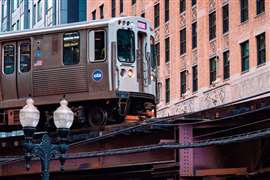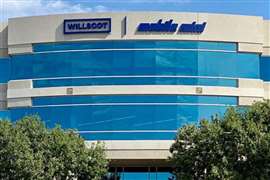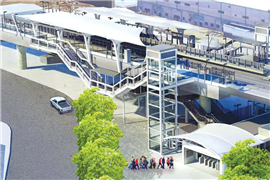A fleet favorite: how RTs are changing the game
16 August 2024
Simple to operate and easy to navigate around a jobsite, rough terrain cranes are critical tools on large and small projects. And despite inflation and higher interest rates posing challenges, the RT market remains strong, according to Brian Peretin, general manager of sales for mobile and crawler cranes for Liebherr USA.
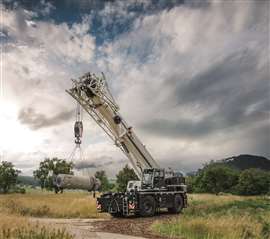 Liebherr LRT 1130-2.1 CAPACITY OF CRANE: 140 tons MAIN BOOM LENGTH: 197 feet FIXED JIB LENGTH: 85 feet BOOM LENGTH WITH JIBS: 282 feet COUNTERWEIGHT: 45,400 pounds
Liebherr LRT 1130-2.1 CAPACITY OF CRANE: 140 tons MAIN BOOM LENGTH: 197 feet FIXED JIB LENGTH: 85 feet BOOM LENGTH WITH JIBS: 282 feet COUNTERWEIGHT: 45,400 pounds
“The large data center and chip facility projects seem to be absorbing a significant number of RTs,” said Beau Pocock, business development manager and product specialist for RTs, ATs and telecrawlers for Liebherr USA. “Traditional users such as petrochemical projects and infrastructure jobsites continue to utilize a good deal of RTs.”
Pocock said the 100-ton class has seen the greatest growth in the past several years, and the demand for even larger RTs continues to expand.
“The 140-ton Liebherr LRT 1130 has performed very well in the U.S. market,” Pocock said. “Equipped with the largest capacity on two axles and 197 feet of main boom makes this crane a strong performer in the larger RT segment.”
But he also contends the 100 to 110-ton market remains solid. In terms of what customers are looking for, Pocock said it’s mainly reliability, ease of use and value.
“There is also an added emphasis on safety with RTs,” he said. “Liebherr machines come with standard options, including an anemometer and navigation light, step ladder for maintenance, camera system, maintenance tools and safety markers. The cab also offers first-rate comfort and visibility with all the creature comforts an operator could want.”
Most manufacturers offer these same features. The RT market has fluctuated with the health of the oil and gas industry, Pocock said.
“However, with so many large manufacturing facilities being built, such as chip plants or data storage centers, the need for 100-plus ton RTs remains steady,” he said. “And with the scope of large projects projected in the future, we feel the RT market will continue to grow at a steady pace.”
In terms of fleet refreshment, Peretin said that most customers are sticking to their general refresh timeline. If anything, they may replace machines sooner.
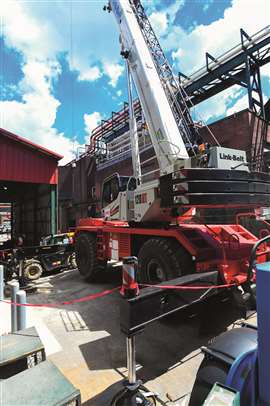 Link-Belt 120|RT CAPACITY OF CRANE: 120 tons MAIN BOOM LENGTH: 164.1 feet OFFSETTABLE FLY: Two-piece 35-foot to 58-foot COUNTERWEIGHT: 28,000 pounds
Link-Belt 120|RT CAPACITY OF CRANE: 120 tons MAIN BOOM LENGTH: 164.1 feet OFFSETTABLE FLY: Two-piece 35-foot to 58-foot COUNTERWEIGHT: 28,000 pounds
“RTs serve multiple needs on almost every jobsite,” Pocock said. “They are used in refineries, road and bridge construction, wind, oil and gas, steel erection and more. Given their flexibility, it is probably easier to list the jobsites that you wouldn’t find an RT crane working.”
Steady growth
Link-Belt’s Kelly Fiechter said RTs fit the needs of all sorts of jobs, and the RT market has been growing steadily, year over year, since the end of 2020.
“The RT market is good across North America, but the Gulf Coast region is consistently the strongest region for RTs,” Fiechter said. “The most popular tonnage class continues to be the 100-ton class for RTs. We think our 100-ton 100|RT offers the right mix of capacity, boom length, ease of operation and transportability, which gives RT owners and users confidence in our cranes.”
Market numbers show demand for larger-capacity cranes is steadily increasing, Fiechter said.
“We see a consistent demand for our larger RT products like our 130-ton RTC-80130 Series II and our 160-ton RTC-80160 Series II, especially for utility and plant work.”
But there’s still a need for smaller capacity RTs, he said.
“We see solid demand for our 50 to 65-ton-capacity RTs,” Fiechter said. “The site requirements and workloads that might have once utilized 30- to 50-ton cranes five or six years ago now seem to require larger cranes. From a rental perspective, having a larger crane in the fleet that can do more work but still be transported in the same way as a smaller crane makes a lot of sense. For instance, our 75-ton 75|RT can be transported in one piece with full counterweight across most of North America.”
According to Fiechter, the lion’s share of RT units in the field today are bare rental units.
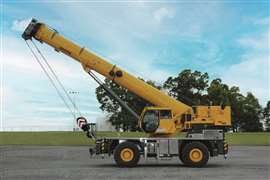 Grove GRT765 and GRT780 CAPACITY OF CRANES: 65 and 80 tons MAIN BOOM LENGTHS: 126 feet/155 feet FIXED JIB LENGTHS: 35 to 56 foot bi-fold swing away jib COUNTERWEIGHT: 15,200 pounds and up to 20,500 pounds
Grove GRT765 and GRT780 CAPACITY OF CRANES: 65 and 80 tons MAIN BOOM LENGTHS: 126 feet/155 feet FIXED JIB LENGTHS: 35 to 56 foot bi-fold swing away jib COUNTERWEIGHT: 15,200 pounds and up to 20,500 pounds
“The most common requirements we hear about from the rental houses that purchase these cranes and their customers are ease of operation, reliability and minimal maintenance,” he said. “Our cranes are built from the ground up with these attributes in mind.”
Link-Belt contends the RT market will grow and then most likely level off by the end of the year. Fiechter said Link-Belt customers are refreshing their fleets more than in the past.
“With a focus to gain a competitive advantage, companies are regularly refreshing their fleets to be more efficient and reliable,” he said. “The pandemic may have disrupted the replacement cycle momentarily, but we expect to see a continued increase in fleet turns over the next few years.”
Large jobsites like refineries, mine sites and water treatment plants are ideal jobs for RTs.
“But also, RTs work well at small jobsites where space is limited, as they are nimble and highly maneuverable,” said Fiechter. “The very utilitarian nature of these cranes often makes them the most economical choice for a lot of different kinds of work.”
Strong utilization
John Bair, product manager for rough-terrain cranes at Manitowoc, said that overall RT crane utilization is strong.
“Infrastructure and energy are key drivers for the RT market and we are seeing many large infrastructure projects that are just getting started and will demand a lot of RT cranes over the next several years,” he said. “In addition, we are seeing many fleets that are going through replenishment cycles where they are transitioning out of older equipment and looking to purchase new equipment to stay current with the latest technologies.”
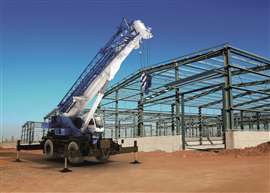 Tadano GR-1300XL-4 CAPACITY OF CRANE: 130 tons MAIN BOOM LENGTH: 183.7 feet FIXED JIB LENGTH: 33.8 feet/59.1 feet MAX BOOM LENGTH WITH JIBS: 242.8 feet COUNTERWEIGHT: 43,500 pounds
Tadano GR-1300XL-4 CAPACITY OF CRANE: 130 tons MAIN BOOM LENGTH: 183.7 feet FIXED JIB LENGTH: 33.8 feet/59.1 feet MAX BOOM LENGTH WITH JIBS: 242.8 feet COUNTERWEIGHT: 43,500 pounds
Bair agreed that the 100-ton class continues to see the highest volumes in the RT market, largely due to their versatility on a wide variety of jobs.
“They have enough boom length and capacity to handle many applications, while still being compact and light enough for easy transport and then excellent maneuverability once on site,” he said. “The 100-ton RTs are easily bare rented due to their simple and quick, full power boom designs.”
Manitowoc is still seeing demand for RTs in the 30 to 65-ton capacity range as well.
“Perhaps not the volumes you saw 10 to 15 years ago due to the wide variety of equipment available that can handle similar jobs, but there is still a need for small RTs, and there are many customers looking to replace older equipment in this range,” Bair said. “But capacity and boom length requirements are always increasing as jobsites get more congested, lifts get further away and the loads continue to get heavier. All of which are substantiating the growth in the larger 120- to 165-ton class of RT cranes.”
This has been an area of focus for Manitowoc. The company recently launched the 120-ton GRT8120 and 165-ton GRT9165, both of which have been successful cranes, he said.
“Customers love the long reach of the 197-foot boom on the GRT8120, but really appreciate the compact carrier that it sits on, which is similar to that of a typical 80- to 100-ton crane. Then when you jump to the GRT9165, you are going to another level of lifting capabilities and the applications are quite broad. We’ve seen the GRT9165 on wind farms, in refineries, doing dock work, working in residential construction, doing precast panel work, working in mines and the list goes on.”
In general, Bair said customers want versatility, reliability and ease of operation.
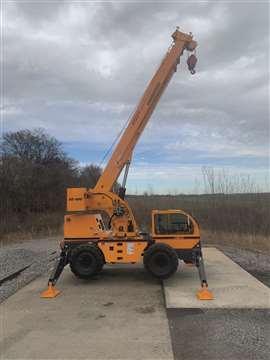 Broderson RT-400-B CAPACITY OF CRANE: 20 tons MAIN BOOM LENGTH: 68 feet fixed jib Length: 17 feet BOOM LENGTH WITH JIB: 85 feet COUNTERWEIGHT: 82,50 pounds
Broderson RT-400-B CAPACITY OF CRANE: 20 tons MAIN BOOM LENGTH: 68 feet fixed jib Length: 17 feet BOOM LENGTH WITH JIB: 85 feet COUNTERWEIGHT: 82,50 pounds
“For instance, a versatile crane would not only include strong load charts and a long boom, but also ease of transport and set up, as well as compact dimensions for excellent mobility on site,” he said. “With RTs, and really any product, reliability is huge, customers need to know when the crane shows up on the job, it can be counted on for the entirety of the project.”
He agreed that ease of operation is critical because RT cranes are typically bare rented.
“Making the operating systems and RCLs simple and intuitive is very important,” he said. “These three points are critical anytime we are designing a new crane and are why we not only look to enter the market with best-in-class capacities and boom length, but also look to minimize our footprints while also integrating our intuitive Crane Control System (CCS) that allows for simple and fast operation, and also boasts advanced on-board diagnostic tools that ensures maximum uptime and ultimately an excellent ROI.”
Bair said that RTs are used for so many different types of applications, largely in part because they are predominately a rental crane. And also, the size of the crane is important.
“When you are talking about lower capacity RT’s, you are seeing them doing plant maintenance work, laydown yard work, as well as bridge and highway jobs,” Bair said. “As you start to get into the mid-range of RTs, you see them doing anything from steel erection to working in refineries, traversing and working in mines, not to mention utility and powerline infrastructure. The large class of cranes can be used on wind farms, refineries as well, large general construction projects and dock work. The list can go on.”
Infrastructure boom
The North American market has been fluid recently, being driven by infrastructure projects such as airport expansions, bridge and highway construction, wind maintenance assist cranes, data and server centers, semiconductor plants and projects related to oil and gas in addition to LNG,” said Dan Melnyk, director or North American sales for Tadano. “The North American market has seen heavier demand for RTs in the 80-ton class and above. The larger RT market has been very strong and continues to be one of our top segments.”
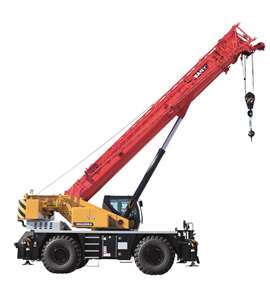 Sany SRA1200A CAPACITY OF CRANE: 120 tons MAIN BOOM LENGTH: 183.7 inches feet 7 inches FIXED JIB LENGTH: 34.4 to 59.1 feet BOOM LENGTH WITH JIB: 242.8 feet COUNTERWEIGHT: 29,800 pounds
Sany SRA1200A CAPACITY OF CRANE: 120 tons MAIN BOOM LENGTH: 183.7 inches feet 7 inches FIXED JIB LENGTH: 34.4 to 59.1 feet BOOM LENGTH WITH JIB: 242.8 feet COUNTERWEIGHT: 29,800 pounds
While demand for smaller RTs has been steady, Melnyk said, it’s still much less than the 80-ton capacity and above market.
Tadano has long been synonymous with reliability and low operating costs, according to Lance Rydbom, director of product management and engineering.
“Our customers take full advantage of these characteristics and enjoy low cost of ownership and high residual values for their Tadano rough terrain cranes,” he said. “The market seemed to cool slightly in recent months, however, the information we are hearing from the market seems to indicate customers believe there will be an increase in activity from the end of the third quarter and into the fourth quarter.”
Fleet refreshment has been consistent.
“One change we have seen for some fleets is a request to refurbish their existing aged Tadano rough terrains and make them ‘new’ again,” Rydbom said. “The steel works are still in great shape, but they would like to modernize and refresh where it makes sense to extend the life of their Tadano cranes.”




